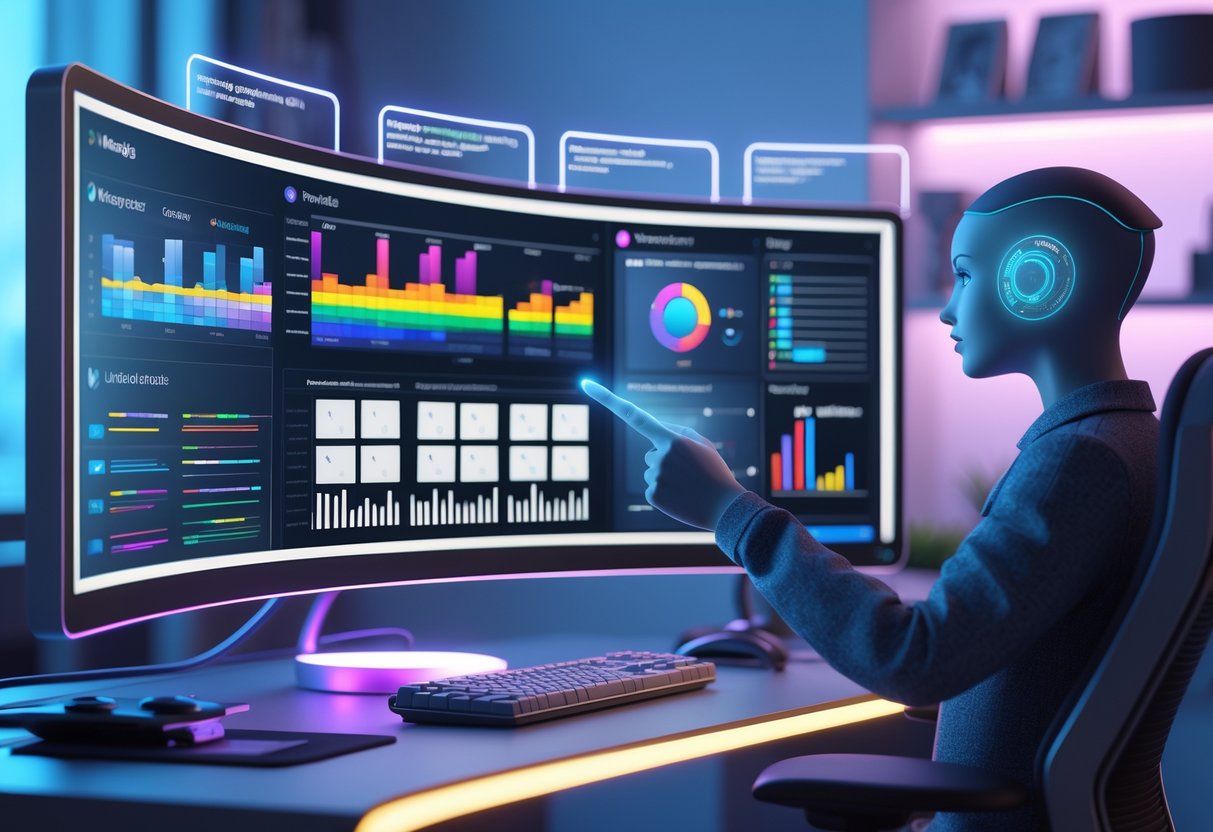VOD Review Techniques: Mastering Effective Game Analysis
Updated On: November 12, 2025 by Aaron Connolly
Core Principles of VOD Review
If you understand how VOD review works and dodge the usual mistakes, you’ll get way more out of your gameplay analysis. The trick is to focus on feedback you can actually use, not just trying to fix everything all at once.
Defining VOD Review Techniques
VOD review is basically just watching your own gameplay recordings to spot mistakes and figure out how to get better. You’ll notice stuff you totally missed while playing live.
Some basic VOD review techniques are:
• Solo analysis – Watch your own games by yourself and jot down notes.
• Guided review – Go over games with a coach or teammate to find patterns.
• Comparative analysis – Compare what you did to what pros do in similar spots.
Pick the approach that matches your experience. Newer players should probably focus on the obvious stuff, like bad positioning or timing goofs.
If you’re more experienced, dig into your decision-making and game sense. Ask yourself why you took a certain path, or if there was a smarter option.
Quick tip: Keep review sessions short—just 10-15 minutes. That way, you won’t burn out and can actually focus on what matters.
Benefits of Structured VOD Reviews
Structured VOD reviews help you see progress and save you from wasting time on stuff that doesn’t matter. You focus on a few key things, not every tiny detail.
Big wins you’ll see:
• Pattern recognition – You’ll spot mistakes that keep popping up.
• Better decisions – Understanding your choices helps you improve next time.
• Faster skill growth – Targeted practice beats just grinding games.
Lots of players notice real improvement after a couple of weeks of regular VOD review. You’ll start making smarter calls in live games since you’ve thought those situations through already.
Heads up: Don’t expect magic overnight. Progress takes time, but VOD review actually speeds things up.
The structure also makes it easier to review games with a coach or teammates. Everyone stays on the same page and can track what’s getting better.
Common Pitfalls and How to Avoid Them
Most of us fall into the same traps with VOD review. If you know what to watch out for, you’ll save yourself a lot of time and stress.
Some of the big mistakes:
| Pitfall | Why It Happens | Solution |
|---|---|---|
| Over-analyzing mechanics | Aim mistakes are easy to see | Focus more on positioning and timing |
| Taking too many notes | Wanting to fix everything | Limit yourself to 3-4 main points per session |
| Only reviewing losses | Losses feel more important | Review wins to reinforce good plays |
Try not to get hung up on every missed shot or mechanical slip. Your aim gets better with practice, but VOD review should mostly focus on decision-making and game sense.
Perfectionism is another trap. You aren’t aiming for perfect play—just for clear improvements you can actually work on.
Keep sessions short and dialed in. Don’t try to break down an hour-long match in one go. Just pick a couple of key moments and really dig in.
Setting Learning Objectives for VOD Analysis

You need to know exactly what you want to fix before you even hit play on your VOD. If you don’t set goals, you’ll just end up watching replays and not really getting anywhere.
Identifying Personal Improvement Areas
Before you dive into a VOD review, try to figure out your biggest weaknesses. Most players try to fix everything, but then nothing really improves.
Ask yourself:
- What cost me the most games last week?
- Which mistakes do I keep making?
- What do my teammates complain about most?
Stick to just one or two things at a time. If you’re struggling with positioning, aim, and comms, pick one—like positioning—and focus on that first.
Some common areas:
- Mechanical skills (aim, movement, ability usage)
- Game sense (timing, positioning, map awareness)
- Team coordination (callouts, rotations, trading)
Sometimes, a coach can really help you spot blind spots. It’s hard to see your own mistakes, but someone else might catch them right away.
Quick tip: Try recording yourself explaining your decisions as you play. Listen back and see where your thinking went off track.
Establishing Clear Review Goals
Once you know your weakness, set a specific goal for each VOD review. Vague stuff like “get better” won’t help.
Make your goals SMART:
- “Count how many times I peek without backup”
- “Find three rounds where better positioning would’ve changed things”
- “Track when my callouts are too late”
Keep a simple tracker:
| Review Session | Focus Area | Mistakes Found | Key Learning |
|---|---|---|---|
| Game 1 | Positioning | 5 bad peeks | Stay behind cover longer |
| Game 2 | Callouts | 3 late calls | Call enemy spots faster |
Cap each session at 15-20 minutes. If you go longer, you’ll just get overwhelmed and start missing stuff.
Don’t try to fix every mistake in one go. Stick to your chosen area and let the rest go for now.
Set targets like “cut my positioning mistakes in half next week” or “make callouts within 2 seconds after seeing enemies.”
Selecting Effective VODs for Review
You’ll only get good results from VOD review if you pick the right games to watch. You need matches that actually show clear learning opportunities and use the right camera perspective so you can spot what went wrong.
Choosing the Right Matches
Go for close losses, not easy wins. These games tell you the most about how you handle pressure.
Look for matches where you felt lost or overwhelmed. That’s usually where your biggest improvement chances are hiding.
Pick recent games—ideally from the last week—since you’ll still remember what you were thinking during the match. It helps you compare your intentions to what actually happened.
Mix up the strategies. Review games against different opponent types:
- Aggressive, early-game teams
- Defensive, late-game teams
- Weird comps or strats you don’t see often
Skip matches where lag or technical problems messed things up. Those don’t teach you anything about your choices.
Try to include both your main picks and champs or agents you’re less comfy on. That way, you can spot different gaps in your skills.
Assessing Perspective: POV Versus Spectator
Your POV recording shows exactly what you saw and did. You’ll see your reaction times, camera placement, and what info you missed in real time.
Use POV footage to break down your mechanics and individual choices. You’ll catch missed chances, bad positioning, and timing errors that spectator mode might not show.
Spectator mode gives you the big picture. You can see where everyone is, what the enemy is up to, and how the map control shifts.
Switch between both during your review. Start with spectator mode to figure out what happened, then flip to POV to see why you made your decisions.
POV is best for mechanics—aim, abilities, reaction speed. Spectator mode works better for strategy and team stuff.
A lot of players only watch spectator replays and miss out on key insights about their own habits.
Structuring the VOD Review Process
If you want your VOD review to actually help, you need a plan and some time limits. Breaking things down into steps—and not letting it drag on—makes it easier to spot mistakes and level up.
Step-by-Step Workflow
Preparation Phase
First, pick which match to review. Choose games where you lost or made some clear mistakes. Recent losses work best since you’ll remember your thought process.
Download the replay and grab something to take notes with. Jot down what you want to focus on—maybe positioning, decision-making, or mechanics.
Individual Review Stage
Watch the match once all the way through without pausing. Jot down the big moments where stuff went wrong. Don’t try to break down every detail the first time.
On your second watch, pause as needed. Focus on just one area. If you’re looking at positioning, ignore mechanical mistakes for now.
Analysis and Documentation
Write down timestamps for the major errors. Note what you did wrong and what you should’ve done instead. Be honest—nobody’s perfect.
Make action points for your next matches. Keep them simple and specific. Instead of “ward more,” try “place wards at river bush every 2 minutes.”
Time Management During Reviews
Setting Time Limits
Don’t spend more than 45 minutes reviewing a 30-minute match. Any longer and you’ll lose focus. Set a timer if you need to.
Split up longer reviews. Your brain just works better in short bursts.
Priority-Based Approach
Start with the game-changing moments. Deaths, missed objectives, and team fights matter more than minor mechanics.
Follow the 80/20 rule—spend 80% of your time on the mistakes that cost you the game. Save the little stuff for later.
Review Frequency Schedule
Limit yourself to one match review per day. If you try to review every game, you’ll just burn out.
Do your reviews when you’re alert. Late-night VOD sessions don’t usually go well. Mornings or afternoons are better for most people.
Wave Management in VOD Reviews
Wave management is the backbone of lane control and map pressure in competitive games. If you review how you handle minion waves, you’ll catch key timing mistakes and missed chances to get ahead.
Analysing Early Game Wave Control
The early wave state sets up your ability to trade, recall, and roam. When you review VODs, look for patterns in how you play the first 10 minutes.
Key things to check:
- Freeze timing – Did you miss chances to freeze waves near your tower?
- Slow push execution – Are you building waves before recalling or roaming?
- Wave crashes – Are you timing recalls with cannon waves hitting their tower?
Lots of players struggle to know when to break a freeze. Pause your VOD when minions hit certain spots and ask, “Should I just last-hit here, or do I need to change the wave?”
Common mistakes you’ll probably see:
| Mistake | Impact | Fix |
|---|---|---|
| Random trading while pushing towards enemy | Lose CS and position | Only trade when the wave favors you |
| Recalling at bad times | Miss 2-3 waves | Wait for cannon to crash |
| Ignoring enemy wave | Get ganked easily | Track their freeze/push patterns |
Watch out for autopilot farming. Great players always adjust based on where the minions are.
Evaluating Lane Manipulation Strategies
If you want to get good at wave management, you’ll need to set up situations on purpose. When you review your VODs, focus on whether you’re really giving yourself chances to grab objectives and dodge enemy pressure.
Strategic elements to check:
- Roam timing – Did you shove the wave before helping your team?
- Gank setup – Are you setting up your lane so your jungler can gank?
- Recall coordination – Does your wave management line up with when you want to buy items?
Keep an eye out for missed slow push opportunities. If you stack up 6+ minions, pause and ask yourself—did you actually use that pressure, or just let it fizzle?
Advanced patterns to spot:
Most of us miss bounce timing—that moment when the enemy wave will push back to you. In your review, mark those spots. If you want to manage waves well, you’ve got to predict these bounces 30-60 seconds ahead.
Check your priority windows too. When you clear a wave fast, did you use that 10-15 second gap to ward, trade, or pressure an objective?
Quick win: Drop a timestamp for every wave manipulation you try. Rate each as a win, fail, or missed chance. This helps you spot patterns way faster than just watching through.
Identifying Mistakes and Missed Opportunities

The hardest part of VOD review isn’t catching obvious errors—it’s figuring out what’s bad luck and what’s just a bad decision. We’ve got to separate plays that worked by accident from smart ones that just didn’t pan out.
Recognising Outcome Versus Decision Quality
A good decision can blow up in your face. A bad play can somehow work out.
So, judging your gameplay by results alone? That’s not it. Maybe you clutched a round by running through smoke. Sure, it worked, but was it a smart call? Probably not.
Focus on the info you had at the time. Did you know where the enemies were? Was your team actually ready to follow up? These details matter way more than whether you won the fight.
Look for patterns in how you make choices. Maybe you always peek without checking your minimap. The result changes, but the mistake doesn’t.
Heads up: Don’t throw out good plays just because they didn’t work. If you made a solid call with the info you had, that’s still progress—even if luck wasn’t on your side.
Here’s what you should track:
• Info you had – Did you know it, or just guess? • Risk/reward – Was it worth it? • Team coordination – Was your squad ready to help? • Timing – Did you have enough time to pull it off?
Spotting False Positives and False Negatives
We obsess over tiny mistakes and miss the big ones.
False positives happen when you blame yourself for stuff that wasn’t really your fault. Missed a tough shot? Sometimes the enemy just outplayed you.
False negatives are the sneaky killers. Bad positioning that led to your “unlucky” death. Awful timing that forced you into a losing duel.
Start by breaking down your deaths. Watch the 30 seconds before each one. Usually, the real mistake happened way before the fight.
Check for these hidden problems: • Map awareness – Did you ignore pings or the minimap? • Resource management – Were you low on health or abilities? • Positioning – Did you put yourself in a terrible spot before the fight?
Quick win: Write down what you were thinking during big moments. Then compare your assumptions to what actually happened. You’ll see where your game sense needs work.
Don’t trust your memory. What felt like good positioning in the moment might look awful when you watch it back.
Exploring Alternative Decisions and Outcomes

When you review VODs, you should look at the choices you could’ve made and imagine how things might have gone differently. This is how you find better plays and learn the real impact of your actions.
Assessing Different Play Options
Pause your VOD at key moments. List every choice you had—different positions, abilities, or strategies.
Jot down 3-4 other plays for each big decision. If you pushed a lane, what if you’d stayed back, ganked mid, or taken an objective?
Ask for each option:
- What resources would this need?
- Which teammates would need to help?
- What map control would we get?
- How would the enemy probably react?
Build a simple table. Rate each on safety, reward, and team coordination. Patterns will start to pop up.
Usually, the best alternatives involve just a different timing—not a whole new plan. Moving five seconds sooner or waiting for a teammate can flip the script.
Anticipating Consequences of Choices
For every alternative, think through what would’ve happened next. This trains your brain to plan ahead in real matches.
Map out the chain:
- Your alternative move
- Enemy’s likely reaction
- Follow-up chances or problems
- End result vs. what actually happened
Look at both best- and worst-case scenarios. Games rarely go perfectly, so knowing the risks helps you make smarter calls under pressure.
Check your team’s position and resources before deciding. Sometimes a risky play works if you’re full health, but falls apart if you’re low.
Don’t just focus on failures. Sometimes you got lucky with a bad call, and reviewing alternatives shows why a safer play would have been smarter in the long run.
Utilising Coaching and Peer Feedback

Working with other players and coaches changes how you approach VOD review. Collaborative sessions help you spot mistakes you’d never see solo, and you’ll pick up new ways of thinking from everyone’s feedback.
Collaborative VOD Review Sessions
Group VOD reviews create a learning environment where different perspectives sharpen your analysis. Set these up with teammates, friends, or anyone at your level.
Start with a clear goal for each session. Pick one thing—like positioning or team fighting—to keep everyone focused.
Assign roles to each person. One runs the video, others watch for map awareness or cooldowns. Switch up roles next time.
Drop timestamp markers when someone spots a big play or mistake. Go back and break it down together.
Try this feedback format for review sessions:
- 5 minutes: Watch the clip, no talking
- 10 minutes: Everyone shares first impressions
- 15 minutes: Dig into the details
- 5 minutes: List key takeaways
Record these sessions if you can. Sometimes you catch new insights when you watch your own review.
Integrating Constructive Criticism
Giving and taking feedback well makes these reviews way more useful. Focus on specific actions, not vague performance stuff.
Use the “observation-impact-suggestion” method. Say what you saw, explain how it affected the game, and suggest a better idea. For example: “At 12:30, you engaged without vision on their jungler, which led to a 2v1. Maybe ward first or wait for backup?”
Ask questions, don’t just make statements. Try, “What info did you have when you made that choice?” It helps people think instead of getting defensive.
Set some ground rules:
- Talk about gameplay, not the person
- Always back up feedback with timestamps
- Offer alternatives, don’t just point out mistakes
- Let the reviewed player explain their thinking
Listen actively during feedback. Take notes and ask questions if you’re confused. The point is to get better, not to win an argument.
Keep a feedback log to track the same issues over time. Patterns show you exactly what to work on next.
Leveraging Tools and Technology for Analysis

With the right tools, you can turn hours of video into focused practice. Cloud-based platforms make it easy to store, share, and mark up gameplay with your team or coach.
Recommended VOD Review Software
Insights gives esports teams a powerful cloud-based platform for reviewing VODs together. Their collaborative features let multiple people break down footage at the same time. You can build shared libraries of key plays and set up custom review templates.
Coachable shines at timestamping and annotation. It’s built for video feedback, with drawing tools and visual markers to point out positioning or tactical mistakes.
On a budget? UI Vision is a free browser extension. It’s basic, but works for solo reviews. If you know some coding, Python tools like Pandas and Matplotlib let you dig into stats in detail.
| Platform | Price Range | Best Feature | Team Size |
|---|---|---|---|
| Insights | £15-50/month | Collaborative review | 3-15 players |
| Coachable | £20-40/month | Visual annotations | 1-10 players |
| UI Vision | Free | Basic functionality | Solo use |
Quick tip: Try free tools first to build your routine before you pay for premium stuff.
Annotating and Timestamping Key Plays
Good annotations zero in on exact moments, not just general trends. Mark the timestamp for rotations, team fights, or when you mess up positioning. Stick to a colour code—red for mistakes, green for good plays, yellow for learning moments.
Most tools let you go frame-by-frame. That’s super handy for catching split-second errors in games like Counter-Strike or Valorant.
Use standard comment templates for common problems. Instead of just “bad positioning,” write something like “exposed to long angles at 14:23, no cover.”
Don’t overdo it with annotations. Focus on 3-5 key moments per round. If you mark everything, you’ll just overwhelm yourself.
Share annotated reviews within a day, while the match is still fresh. Fast feedback helps you improve way quicker.
Tracking Progress and Setting Future Goals

VOD review only works if you actually track your progress and change your approach based on what you learn. That’s how you turn random practice into real skill growth.
Documenting Improvement Over Time
You need a clear way to see if your reviews are paying off. Lots of players watch their footage but never check if they’re fixing the problems they find.
Set up a tracking spreadsheet with these columns:
- Date of review
- Specific mistake
- What you did to fix it
- Follow-up check (did you improve?)
If you spot the same positioning mistake in three matches, write down the details. Then check if you’re still making that mistake in your next five games.
Weekly progress checks work best. Review your notes every Sunday. Mark which issues are gone and which keep popping up.
A lot of players use a simple colour system:
- Red: Still making this mistake often
- Amber: Getting better, but not consistent
- Green: Fixed it
This visual tracker helps you focus your next reviews on the stuff that really needs work.
Adapting Strategies Based on Review
You’ll want to tweak your VOD review method as you get better. What fixes basic mistakes just won’t cut it for advanced gameplay patterns.
Beginners should stick to one mistake type each week. If you keep dying too much, just look for those death scenarios in your VODs. Don’t try to fix aim, positioning, and comms all at once—seriously, it’s too much.
Intermediate players need to start focusing on how opponents punish their errors. Instead of only watching your own mistakes, pay attention to how enemies take advantage. This helps you learn to think like a stronger player.
Advanced reviewers benefit from comparative analysis. Watch your gameplay side-by-side with pro matches in similar situations. Notice the differences in timing, positioning, and decisions.
You’ll want to adjust your review frequency, too:
- Learning a new role: Do daily 10-minute reviews.
- Rank climbing: Try three detailed sessions each week.
- Maintaining skills: Go for one thorough review weekly.
Quick win: Set monthly review goals, not daily ones. “Fix my early-game deaths by month-end” feels way more doable than “improve everything this week.”
Common Challenges and Solutions in VOD Reviews

VOD reviewing sounds simple until you actually start doing it a lot. The hardest parts? Staying neutral about your own play and dealing with the frustration of watching yourself mess up.
Maintaining Objectivity
Watching your own gameplay needs brutal honesty. Most of us struggle to see our mistakes because we remember exactly what we were thinking at the time.
Stick to facts, not intentions. Maybe you planned a smart flank, but if you died alone, that’s what matters. Write down what actually happened—skip the explanations for now.
Use a structured checklist to keep your reviews on track:
- Map awareness moments
- Resource management errors
- Positioning mistakes
- Communication gaps
Give yourself time limits for each part. Spend 5 minutes on laning, 10 on team fights, and 5 on late-game choices.
Review games from different time periods. Analysing a fresh loss hurts more than watching an old match. Start with older replays to practice being objective.
Dealing with Emotional Bias
Watching yourself throw a game can trigger real frustration. That feeling clouds your judgement and slows down your learning.
Take breaks when you get annoyed. If you catch yourself blaming teammates or making excuses, just pause. Come back in 20 minutes when you’re calmer.
Pick one thing to improve per session. Don’t try to fix everything—choose positioning or map awareness, not both.
Make a “wins and losses” note system:
- What went well this match?
- What cost us the most?
- Which mistake could I fix next time?
Watch pros mess up, too. Even top players miss skill shots or get caught out. It helps to see mistakes as normal, not as personal failures.
Best Practices for Continuous Improvement

You’ll get the most from VOD analysis by building consistent habits and letting your methods evolve. A regular review schedule keeps you improving, and mixing up your techniques keeps things fresh.
Establishing a Routine Review Schedule
Consistency beats intensity for VOD improvement. Set up a weekly schedule that fits your team’s availability.
Daily micro-reviews work well for solo players. Spend 15-20 minutes on one key moment from recent games. Stick to a single aspect like positioning or decisions.
Team reviews work best twice a week. Do one session for recent matches and another for scouting opponents. This way you avoid overload but keep making progress.
| Review Type | Frequency | Duration | Focus |
|---|---|---|---|
| Individual | Daily | 15-20 mins | Single skill area |
| Team | Twice weekly | 45-60 mins | Match analysis |
| Opponent study | Weekly | 30 mins | Strategy prep |
Quick win: Use shared calendars to book review slots ahead of time. Teams that schedule reviews get 40% better attendance than those who wing it.
Track your sessions in a simple spreadsheet. Jot down what you covered, key findings, and what to hit next. This helps keep everyone accountable and shows your progress.
Evolving Your VOD Review Techniques
Let your analysis methods grow as your team levels up. Start with basic gameplay review, then add more advanced stuff.
Begin with observer mode analysis for team play. Watch full rounds and focus on comms and positioning. Once you’re comfortable, switch to individual player views.
Warning: Don’t try every new method at the same time. Get the hang of one before adding another.
Advanced teams get a lot from comparative analysis. Watch your rounds alongside pro teams in similar situations. You’ll spot strategic gaps you might’ve missed.
Rotate who leads review sessions each month. Different people catch different things. Coaches shouldn’t always run the show—player-led sessions often reveal issues coaches miss.
Asynchronous reviews are great for busy teams. Record your analysis and let teammates watch when they can. Meet up later for a quick discussion to clear things up.
Try micro-focused sessions for specific weaknesses. Spend a whole session on something like economy management or site executes instead of reviewing everything.
Frequently Asked Questions

VOD reviews always bring up questions about methods, tools, and how to actually make it work. Here are some answers to help you get more out of your review sessions.
What are the most effective methods for analysing gameplay in VOD reviews?
The best analysis focuses on three things: decision-making, mechanics, and team coordination. Watch the match once without pausing to get the big picture.
On your second watch, pause at key moments and ask yourself: Why did I pick that spot? What info did I have? Could I have called something out better?
Break each round or phase into simple segments. Look at opening moves, mid-game rotations, and late-game decisions separately. You’ll start to notice patterns.
Quick win: Just focus on one thing per session. Trying to analyse everything at once is a recipe for overload.
Which software platforms are recommended for conducting efficient VOD reviews?
Most competitive games come with built-in replay systems—they’re usually the best bet. Games like CS2, Valorant, and League of Legends let you switch perspectives and scrub timelines right in the client.
For recording, OBS Studio stands out as the free go-to. It records high-quality footage without tanking your FPS.
Pro teams often use tools like Insights.gg or GamePlan.gg for extra analytics. These cost £15-50/month but offer stats and auto-highlights.
On a budget? Windows Game Bar or NVIDIA ShadowPlay get the job done. They’re free and let you review footage in any video player.
What steps should I take to ensure a comprehensive self-review of my gameplay recordings?
Start by making a checklist before you watch. List the areas you want to check—maybe positioning, aim, or comms.
Watch the match three times, each with a different focus. First for overall flow and big mistakes, second for mechanics and decisions, third for team play and missed chances.
Take notes with timestamps so you can jump back to important moments later.
Warning: Don’t review matches right after playing, especially if you’re tilted. Wait a few hours so you can focus on learning, not just venting.
Set aside 30-45 minutes per review. If you rush, you’ll miss the details that actually help you improve.
Can you suggest any techniques for identifying key moments in a match when reviewing a VOD?
Look for round-deciding moments or big objective fights—these show how you handle pressure.
Watch for momentum shifts between teams. Break down what caused them and what you could’ve done differently.
Pay close attention to deaths and kills, especially early picks that put your team behind. Figuring out why those happened is huge.
In games with buying phases, check your economic decisions. Messing up money can cost you several rounds.
Use the scoreboard and timeline to spot hot and cold streaks. Sudden drops in performance usually point to specific problems.
What are the best practices for recording gameplay for post-match analysis?
Record at your native resolution and at least 60fps. Lower frame rates make it tough to see timing or mechanical mistakes.
Turn on voice recording to capture team comms. Sometimes you only realize what went wrong when you hear the calls.
Keep your recordings organized—use clear names with date, map, and opponent. This makes it easier to track progress over time.
Record wins and losses, but focus on close games. Those tight matches usually show your real skill level and where you need work.
If you’re in a team game, try recording your view and a teammate’s. Multiple angles give you better context for team issues.
How can I incorporate feedback from VOD reviews into my training regimen to improve performance?
Start by creating practice drills that target the exact problems you spot in your reviews.
Let’s say you keep messing up your crosshair placement. Set aside 15-20 minutes each day for aim training that zeroes in on that issue.
Set goals you can actually measure for each session, and make sure they tie directly back to what you saw in your VODs.
For example, don’t just say “improve positioning.” Try something like, “check the minimap every 10 seconds,” or “keep my crosshair at head level 90% of the time.”
Stick to a regular review schedule. Weekly one-hour sessions work way better than cramming four hours into a single marathon once a month.
If you can, talk through your analysis with teammates or coaches. Other people often catch things you’ll just overlook.
Keep an eye on your progress by comparing your latest gameplay to older clips. Watching yourself improve can really help when things get tough.
Quick win: Tackle one big issue at a time. If you try to fix everything all at once, you’ll probably end up barely improving at all.

